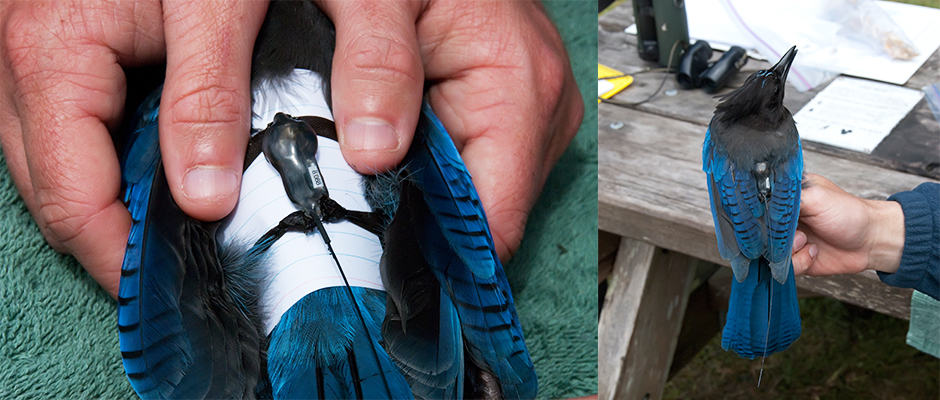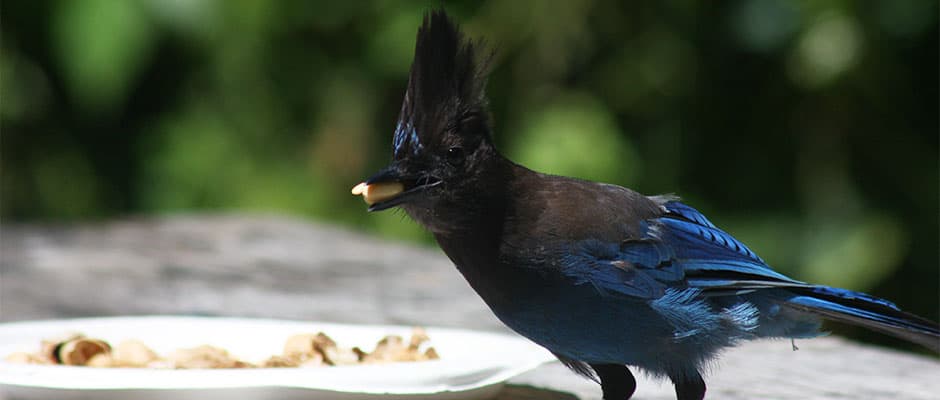Share this article
Human food scraps change Steller’s jay behavior
Crumbs on a picnic table may seem like a minor way to alter an ecosystem, but they and other campground refuse are enough to restructure how jays use space, according to new research. In California’s Redwood National and State Parks, Steller’s jays (Cyanocitta stelleri) that lived near campgrounds had densely overlapping territories, and they spent more time near the ground than their deep-woods kin. The jays’ altered behavior could have unpredictable consequences for species that campers never see, including a threatened seabird called the marbled murrelet (Brachyramphus marmoratus).
“Steller’s jays are attracted to the campgrounds for food,” said Will Goldenberg, who conducted the study recently published in The Condor: Ornithological Applications for his master’s thesis at Humboldt University. “The concern is that these Steller’s jays are now going to predate our marbled murrelets that could be nesting right above these campgrounds, way up in some of the tallest trees in the world.”
Goldenberg first recognized the ecological threat posed by members of the crow family, known as corvids, while he was studying threatened snowy plovers (Charadrius nivosus) as an undergraduate research assistant at Humboldt University. Time and again, says Goldenberg, he saw the shorebirds’ eggs destroyed by hungry corvids that were drawn to the beach by human food scraps. Researchers suspected that the same thing was happening to marbled murrelets, a species that forages at sea and nests in the top branches of redwoods and other conifers. But, says Goldenberg, no one was studying exactly how human food scraps altered corvid behavior, information that could help managers develop strategies to protect threatened birds.

A Steller’s jay is fitted with a radiotransmitter in Prairie Creek Redwoods State Park in 2010. The researchers use an index card to prevent adhesive from sticking to the bird’s feathers, removing the card once the transmitter is in place. ©Sam Price
To find out how camps altered Steller’s jay behavior, Goldenberg and his colleagues attached radio transmitters to 20 Steller’s jays at campgrounds and 10 jays living deeper in the forest. The transmitters, which resembled tiny backpacks with backward-pointing antennae, enabled the researchers to track the birds and monitor their movements. Because of the small sample size, the researchers weren’t able to directly compare how much jays’ ranges overlapped at campgrounds versus deeper in the forest. However, the researchers observed more jays at campgrounds, and the birds’ home range sizes were similar everywhere, suggesting that jays are more willing to share space in areas where human food is plentiful.
A high density of jays at campgrounds could be bad news for marbled murrelets. The few researchers to document the fates of murrelet nests have seen corvids making off with murrelet eggs, says Goldenberg. But Goldenberg’s findings weren’t all bad news for the seabirds. The study found that jays near campgrounds spent more time sitting around resting and more time near the ground, which in theory could reduce their chances of encountering a murrelet nest. More data are needed to determine exactly how campground jays are impacting the threatened seabirds.
But that data could be hard to gather. Marbled murrelets lay eggs on broad branches about 150 feet above ground, easy for jays to access but nearly impossible for most researchers. No one even knew where murrelets nested until the 1970s.
“Their habitat is so inaccessible and so cryptic, it’s difficult to know anything about them,” said Goldenberg.
Managers can still take action to reduce potential harm without waiting for proof of how campground jays harm murrelets. For example, managers could teach the jays to avoid murrelet eggs by tricking them into eating fake eggs that make them feel ill, says Goldenberg.
Of course, the simplest approach is just to keep campgrounds clean. Goldenberg says park managers at his study site have already made great strides toward camp cleanliness, educating campers and installing signs and sealed food containers. In the end, Goldenberg suspects this will be the most important way to reduce the effects campers have on wildlife.
“Human food can really have an impact on birds. And not only these birds that we know are attracted to it,” said Goldenberg. “There’s this cascading effect that that could have on the rest of the environment.”
Header Image: A Steller’s jay forages on a campground picnic table in Prairie Creek Redwoods State Park in 2011. Researchers have found that food scraps at campgrounds alter jay behavior. ©Will Goldenberg








